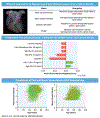Evolving Role of Calcium Density in Coronary Artery Calcium Scoring and Atherosclerotic Cardiovascular Disease Risk
- PMID: 35861969
- PMCID: PMC9908416
- DOI: 10.1016/j.jcmg.2022.02.026
Evolving Role of Calcium Density in Coronary Artery Calcium Scoring and Atherosclerotic Cardiovascular Disease Risk
Abstract
Coronary artery calcium (CAC) is a specific marker of coronary atherosclerosis that can be used to measure calcified subclinical atherosclerotic burden. The Agatston method is the most widely used scoring algorithm for quantifying CAC and is expressed as the product of total calcium area and a quantized peak calcium density weighting factor defined by the calcification attenuation in HU on noncontrast computed tomography. Calcium density has emerged as an important area of inquiry because the Agatston score is upweighted based on the assumption that peak calcium density and atherosclerotic cardiovascular disease (ASCVD) risk are positively correlated. However, recent evidence demonstrates that calcium density is inversely associated with lesion vulnerability and ASCVD risk in population-based cohorts when accounting for age and plaque area. Here, we review calcium density by focusing on 3 main areas: 1) CAC scan acquisition parameters; 2) pathophysiology of calcified plaques; and 3) epidemiologic evidence relating calcium density to ASCVD outcomes. Through this process, we hope to provide further insight into the evolution of CAC scoring on noncontrast computed tomography.
Keywords: atherosclerosis; calcium density; coronary artery calcium; noncontrast computed tomography.
Copyright © 2022 American College of Cardiology Foundation. Published by Elsevier Inc. All rights reserved.
Conflict of interest statement
Funding Support and Author Disclosures Dr Blaha has received grants from the National Institutes of Health, U.S. Food and Drug Administration, AHA, Amgen, Novo Nordisk, and Bayer; and is on the advisory boards for Amgen, Sanofi, Regeneron, Novartis, Novo Nordisk, Bayer, 89Bio, Kaleido, Roche, Inozyme, emocha, VoxelCloud, and Kowa. Dr Dzaye has received support from National Institutes of Health grant T32 HL007227. All other authors have reported that they have no relationships relevant to the contents of this paper to disclose.
Figures






Similar articles
-
Mean Versus Peak Coronary Calcium Density on Non-Contrast CT: Calcium Scoring and ASCVD Risk Prediction.JACC Cardiovasc Imaging. 2022 Mar;15(3):489-500. doi: 10.1016/j.jcmg.2021.09.018. Epub 2021 Nov 17. JACC Cardiovasc Imaging. 2022. PMID: 34801452 Free PMC article.
-
Beyond the Agatston calcium score: role of calcium density and other calcified plaque markers for cardiovascular disease prediction.Curr Opin Cardiol. 2025 Jan 1;40(1):56-62. doi: 10.1097/HCO.0000000000001185. Epub 2024 Oct 9. Curr Opin Cardiol. 2025. PMID: 39445716 Review.
-
Bridging Prevention and Imaging: The Influence of Statins on CAC and CCTA Findings.Curr Atheroscler Rep. 2025 Apr 8;27(1):50. doi: 10.1007/s11883-025-01287-x. Curr Atheroscler Rep. 2025. PMID: 40198377 Review.
-
Discordance Between Coronary Artery Calcium Area and Density Predicts Long-Term Atherosclerotic Cardiovascular Disease Risk.JACC Cardiovasc Imaging. 2022 Nov;15(11):1929-1940. doi: 10.1016/j.jcmg.2022.06.007. Epub 2022 Jul 15. JACC Cardiovasc Imaging. 2022. PMID: 35850937 Free PMC article.
-
Coronary Artery Calcium Volume and Density: Potential Interactions and Overall Predictive Value: The Multi-Ethnic Study of Atherosclerosis.JACC Cardiovasc Imaging. 2017 Aug;10(8):845-854. doi: 10.1016/j.jcmg.2017.04.018. JACC Cardiovasc Imaging. 2017. PMID: 28797404
Cited by
-
Subclinical Hypertension-Mediated Organ Damage (HMOD) in Hypertension: Atherosclerotic Cardiovascular Disease (ASCVD) and Calcium Score.High Blood Press Cardiovasc Prev. 2023 Jan;30(1):17-27. doi: 10.1007/s40292-022-00551-4. Epub 2022 Nov 14. High Blood Press Cardiovasc Prev. 2023. PMID: 36376777 Free PMC article. Review.
-
Screening for Subclinical Atherosclerosis and the Prediction of Cardiovascular Events in People with Type 1 Diabetes.J Clin Med. 2024 Feb 15;13(4):1097. doi: 10.3390/jcm13041097. J Clin Med. 2024. PMID: 38398409 Free PMC article. Review.
-
Association of Carotid Plaque Calcification Attenuation With Intraplaque Hemorrhage Volume: 3D-Segmentation Analysis.J Neuroimaging. 2025 Jul-Aug;35(4):e70071. doi: 10.1111/jon.70071. J Neuroimaging. 2025. PMID: 40658028
-
A Novel Quantitative Computer-Assisted Score Can Improve Repeatability in the Estimate of Vascular Calcifications at the Abdominal Aorta.Nutrients. 2022 Oct 13;14(20):4276. doi: 10.3390/nu14204276. Nutrients. 2022. PMID: 36296959 Free PMC article.
-
Atherosclerosis and the Bidirectional Relationship between Cancer and Cardiovascular Disease: From Bench to Bedside-Part 1.Int J Mol Sci. 2024 Apr 11;25(8):4232. doi: 10.3390/ijms25084232. Int J Mol Sci. 2024. PMID: 38673815 Free PMC article. Review.
References
-
- Agatston AS, Janowitz WR, Hildner FJ, Zusmer NR, Viamonte M, Detrano R. Quantification of coronary artery calcium using ultrafast computed tomography. J Am Coll Cardiol. 1990;15:827–832. - PubMed
-
- Criqui MH, Knox JB, Denenberg JO, et al. Coronary artery calcium volume and density: potential interactions and overall predictive value: the Multi-Ethnic Study of Atherosclerosis. J Am Coll Cardiol Img. 2017;10(8):845–854. - PubMed
-
- Tota-Maharaj R, Blaha MJ, Rivera JJ, et al. Differences in coronary plaque composition with aging measured by coronary computed tomography angiography. Int J Cardiol. 2012;158. - PubMed
Publication types
MeSH terms
Substances
Grants and funding
LinkOut - more resources
Full Text Sources
Medical

